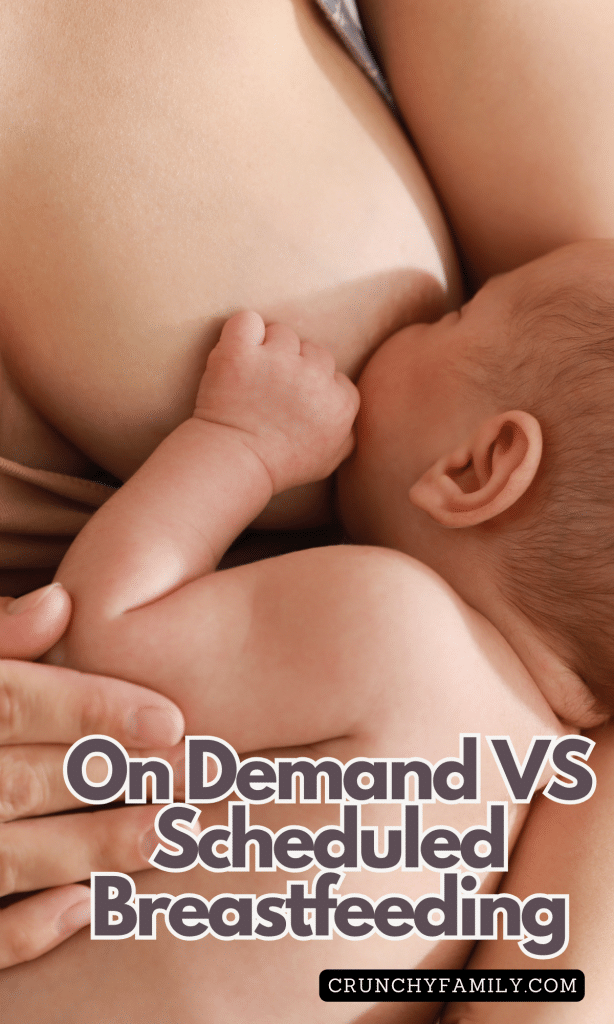When my daughter was born, I found myself in a whirlwind of advice and opinions about the best way to feed her. After considering different approaches, I decided on on-demand breastfeeding because it simply felt right for us.
I remember reading up on scheduled breastfeeding but found it hard to wrap my head around. Implementing a strict schedule seemed like a lot of work, and I wasn’t sure it would fit into our lives. So, on-demand it was, and it turned out to be the best way for us.

On-Demand Breastfeeding
On-demand breastfeeding, also known as responsive feeding, means feeding your baby whenever they show signs of hunger. This approach aligns closely with a baby’s natural needs and rhythms, making it easier to ensure they get enough milk.
Babies’ needs change rapidly, especially in the early weeks of life, and on-demand feeding can help you keep up with their growth spurts and fluctuating hunger levels.
In the first days of life, newborn babies might seem to want to feed all the time. This frequent feeding is perfectly normal and helps establish a good start for breast milk production.

During growth spurts, which often occur around 3 weeks, 6 weeks, and 3 months old, you might notice your baby wanting to nurse even more. These patterns of breastfeeding help boost your milk supply to meet your baby’s increasing demands.
On-demand breastfeeding has several benefits for both the baby and the mother. For the baby, it ensures they get enough milk tailored to their needs. Breast milk changes in composition during a feeding session, with the fat content increasing towards the end, which helps with weight gain and satiety.
For new moms, it can help establish a strong breast milk supply and reduce the chances of painful engorgement.

Responsive breastfeeding can also foster a deep bond between mother and child. The close contact and skin contact during feeds provide comfort and reassurance to your baby. It also helps you become attuned to your baby’s cues, making it easier to respond to their needs, whether they are hungry, need comfort, or are tired.
Scheduled Breastfeeding
Scheduled breastfeeding, on the other hand, involves feeding your baby at set times throughout the day.
This approach can appeal to new parents who thrive on routine and structure. A strict feeding schedule might help some families plan their days better and can be a good idea for those who need to manage their time closely.

However, a scheduled approach requires careful monitoring to ensure that the baby is still getting enough milk. Breastfed infants on a strict schedule might miss out on the opportunity to cluster feed during growth spurts, potentially leading to less milk production.
For this reason, it’s crucial to watch your baby’s cues and adjust the schedule as needed, especially in the early days and weeks of life.
While a scheduled feeding routine can provide structure, it also comes with challenges. Newborn babies don’t always adhere to the clock, and their needs can vary greatly depending on the time of day, growth spurts, or even their mood.

Sticking rigidly to a schedule can be stressful for both the mother and the baby, especially if the baby is not ready to feed or is still hungry after a set time limit.
It’s also important to consider that breast milk supply is driven by demand. The more frequently a baby feeds, the more milk is produced. A strict schedule could inadvertently lead to a lower breast milk supply if it doesn’t align with the baby’s hunger cues.
Many lactation consultants advocate for on-demand feeding, especially in the first month of life, to ensure the baby gets enough milk and to support the establishment of a strong milk supply. New studies suggest that responsive feeding can positively impact a baby’s cognitive development and overall health.

Which One Is Best For Me?
Deciding between on-demand and scheduled breastfeeding can be challenging. To help you determine the best approach for you and your baby, take this quick quiz:
- How do you feel about following a routine?
- A) I love routines and schedules.
- B) I prefer to go with the flow and adapt as needed.
- How well does your baby adhere to set times for feeding?
- A) My baby seems to have regular hunger patterns.
- B) My baby’s hunger cues seem unpredictable.
- How do you handle your own schedule?
- A) I need a structured day to manage my tasks and responsibilities.
- B) I’m flexible and can adjust my schedule based on my baby’s needs.
- How does your baby respond to longer periods between feeds?
- A) My baby seems content with longer breaks.
- B) My baby often needs to nurse more frequently.
- What is your main priority in breastfeeding?
- A) Having a predictable routine for feeding.
- B) Ensuring my baby’s needs are met as they arise.
Results:
- If you answered mostly A: Scheduled breastfeeding might be a better fit for you. A structured approach could provide the routine and predictability you prefer.
- If you answered mostly B: On-demand breastfeeding might suit you better. This approach allows for flexibility and responsiveness to your baby’s needs.

Breastfeeding is a deeply personal journey, and what works for one family might not work for another. Whether you choose on-demand or scheduled breastfeeding, the key is to stay flexible and responsive to your baby’s needs. Keep an eye on their weight gain, wet diapers, and overall satisfaction to ensure they are thriving.
In the debate between on-demand versus scheduled breastfeeding, there is no one-size-fits-all answer. The best way to feed your baby is the one that works best for you and your family.
Whether it’s responding to your baby’s hunger cues throughout the day or adhering to a more structured schedule, the goal is to ensure your baby is well-fed and healthy.

For new mothers navigating this journey, remember that both methods have their merits, and it’s okay to adapt as you learn more about your baby’s needs and your own.
Seek support from lactation consultants, family members, and other new parents to find the best approach for your situation. Ultimately, a happy, healthy baby and a confident, relaxed mother are the hallmarks of successful breastfeeding, no matter the method.
More related reads:
- Breastfeeding Is Easy! Don’t let people tell you otherwise
- What are the Benefits of Comfort Breastfeeding?
- 17 Effective Ways To Reduce Anxiety When Breastfeeding
- Pros and Cons Of Extended Breastfeeding: A Personal Journey
- When Does Breastfeeding Get Easier?
- What is the 2 Shirt Method of Breastfeeding?